When maintenance technicians ask about feeling a vibration, its not just some hipster slang. Excessive vibration in the equipment maintenance world usually means that a machine may be on its way out and costly repairs and plant shutdowns may be imminent. In the manufacturing efficiency arena, this is the worst thing that can happen. It can lead to lost profits and even job loss.
High Precision Maintenance (HPM) -- a term coined by Intel (IW 500/26) for effective equipment maintenance planning -- includes technologies like vibration analysis, infrared scans, laser alignments, precision balancing of rotating equipment, time-domain reflectometry, motor-current signature analysis and electrical systems voltage waveform analysis.
These tools, software programs and preventative maintenance programs are not limited to the high-tech world nor are they exclusive to large companies or facilities. Virtually all plants, including durable goods manufacturers, chemical plants and refineries, aerospace and automotive manufacturers experience similar production pressures and time to market.
For years, manufacturers have struggled with the dilemma of the right planning for maintenance schedules - particularly machines responsible for producing product within tight tolerances and those used to produce high volume products.
Problems like loose or corroded electrical connections, overloaded circuits, or an unevenly worn belt drive on an imbalanced pulley shaft will all perform at diminished efficiency for a while prior to failure.
Even minor issues can cause other machine parts to fail and lead to extensive and costly repairs and downtime. Catastrophic failure can be prevented if these issues are caught early, and peak production volume can be reestablished.
Reactive or emergency work can be as much as five times more expensive to execute than planned and scheduled maintenance, said Shon Isenhour, Director of Education at GPAllied.
Using HPM technology is a great step to developing a world class maintenance department, said Stephen M. Kirwan, BSP Mechanical Planner, Calgon Carbon Corporation. But its important to recognize that HPM tools are used both reactively and proactively in the maintenance process.
Visual cues - high performance signs, labels and tags -- can provide maintenance engineers with precise instructions, maintenance schedules, lockout/tagout procedures, job planning and spare parts inventories. HPM-trained maintenance technicians will determine whether all switches and controls are clearly marked, machine-specific disconnect and isolation points are posted on high voltage equipment and all panels, breakers and switches are clearly marked to identify what they control. Using QR codes on tags enables maintenance engineers to see schematics with smartphones and even order the parts they need right on the spot.
There is no substitute for understanding your equipment and training competent technicians to give it the TLC it needs to live a long and productive life, said Robert L. Fischer, PE, CPE at FischerTechnical.com, an engineer with over 30 years of high-tech maintenance experience.
GM (IW 500/5) Tool & Die operations utilize specialized HPM techniques -- datum invariant mathematics and artificial intelligent decision making maintenance tools --reducing machining errors by 56 percent, according to Ingobert Schmadel, INORA Technologies.
The result? The manufacturer gets the production process under control at a higher level of efficiency. Applied holistic mathematical technology is the real game changer in any future HPM process.
One HPM program Fischer helped develop and implement for an inorganic chemical plant dropped emergency work from 24 percent to 4 percent and increased On-Stream Factor (the time an operating unit actually produces product at a scheduled rate versus the time the unit has been scheduled to produce product) to nearly 99 percent. To put that in perspective: If a plant's annual profit is $100,000,000, every 1 percent of OSF improvement results in at least an additional million dollars profit, he explained.
Infrared cameras can play a key role in HPM. By using sensors that detect thousands of pixels of individual temperature data points, technicians can perform precision temperature-based diagnostics, said Andre Rebelo, FLIR Systems.
When we talk about catastrophic failures, the catastrophe applies not just to the bottom line. Arc flash explosions, electrical failures, high-RPM rotating mechanical components, compromised steam traps all can cause debilitating injuries or worse. Finding ways to preserve a safe workplace can not only save the budget, it can save lives, Rebelo concluded.
A relatively inexpensive introductory tool to start a PdM program is an easy-to-operate Laser Alignment system. Immediate, positive results will follow with extended Mean Time Between Failure of equipment components due to misalignment. Systems can be purchased starting at around $2500, said Stephen M. Kirwan, BSP Mechanical Planner, Calgon Carbon Corporation.
There are several components that must be carefully balanced before any successful HPM program can get underway.
Planning consists of 9 steps:
- Repeatable procedures
- Time requirements
- Parts and material requirements
- Specifications and standards
- Resources identified
- Maintenance skills/training
- Failure mode analysis a successful PM and PDM maintenance program must be created based on specific failure modes and their causes.
- Coordination requirements identified
- Time estimates for craft and job duration
In time, theres no doubt that HPM will be replaced by another buzzword. Like 5S and Six Sigma, its all about staying competitive: developing speed and innovation and establishing new standards and practices. Thats why its important to study and integrate the lessons learned from manufacturers in all industries.
About the Author:
Senior manufacturing efficiency consultant Martin Carter has more than eight years experience with Graphic Products, Inc., a leader in industrial visual communications. For more information, visit www.DuraLabel.com. He may be reached at [email protected].
See Also:
• "Maintenance Best Practices"
• "TPM Delivers a Maintenance Fix"



